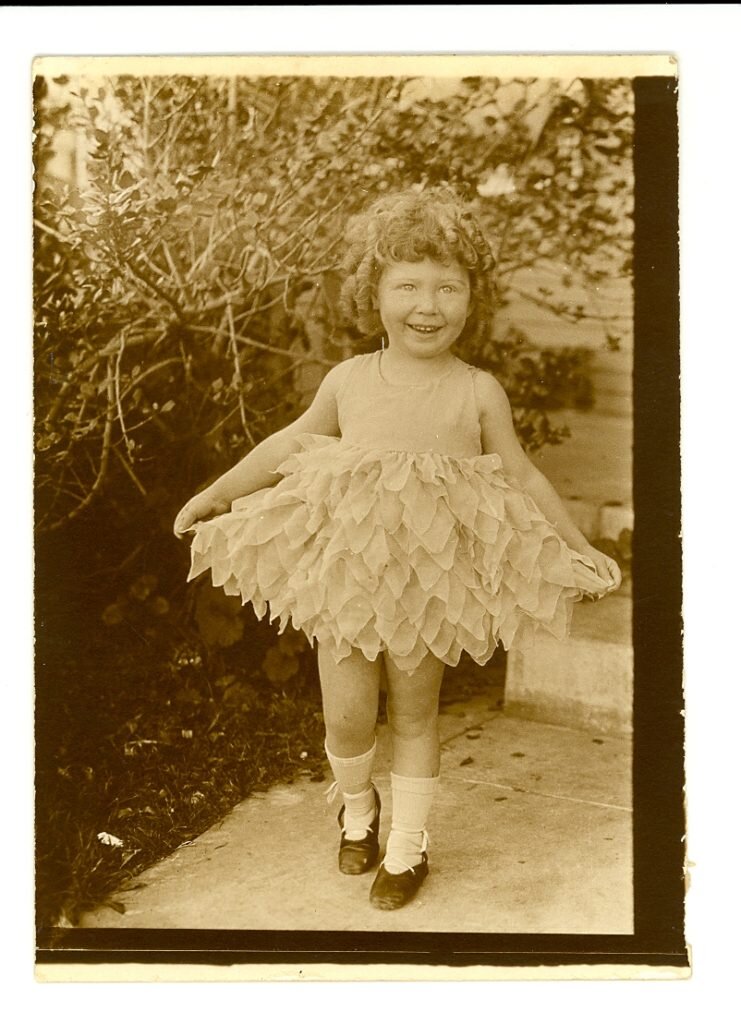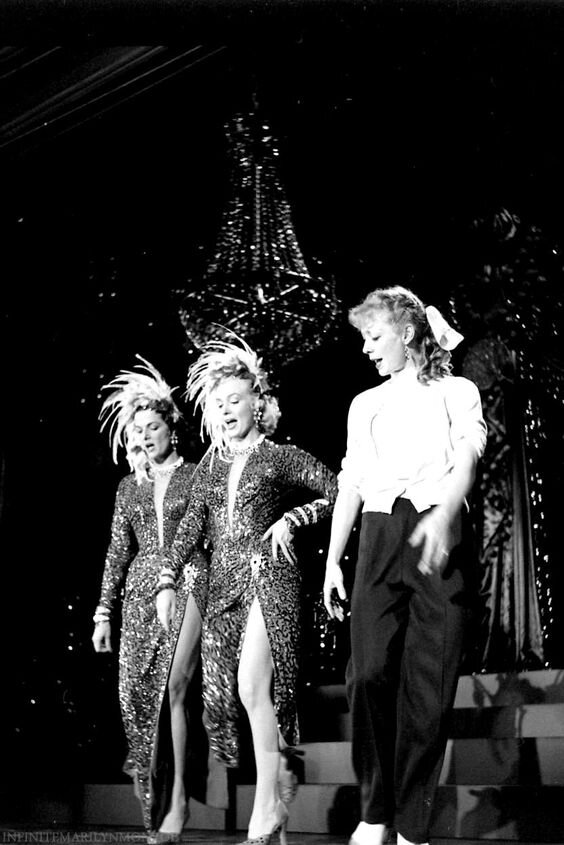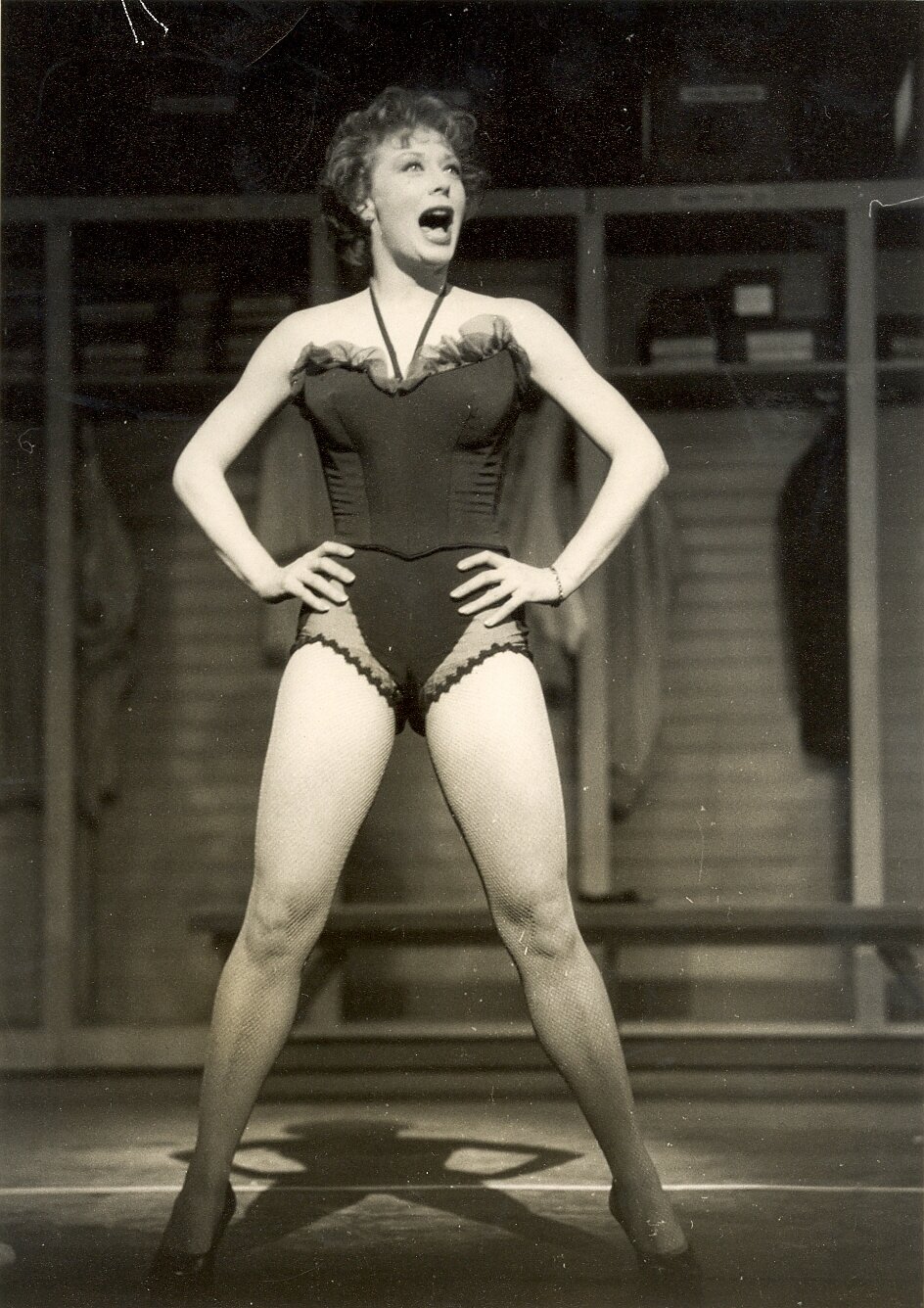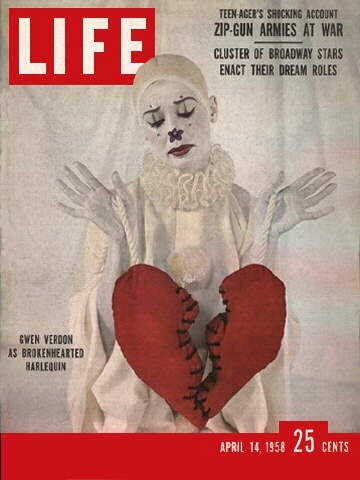Happy birthday, Gwen Verdon!
“Je veux son rôle réduites!” complained Lilo after the first week of try-out performances in Philadelphia. She was the star of CAN-CAN—not Gwen, this redheaded chorus girl from California who seemed to be winning over audiences. So, c’est la vie, Gwen’s already “supporting” role was cut back. Fast forward to CAN-CAN’s opening night at Broadway’s Schubert Theatre: Gwen’s only featured dance number, as Eve in “Garden of Eden” sparked a standing ovation—mid-performance! As rehearsed, Gwen took her exit and went to her dressing room to change costumes. She was interrupted when the producer ran in to tell her that the audience would not stop applauding and cheering her name. Gwen would have to make a curtain call in order for the performance to continue. She returned to the stage, covered with a towel, and was met with an unprecedented seven-minute ovation. There was a new star in town. Her name was Gwen Verdon. Gwyneth Evelyn Verdon was born in Culver City, California on January 13th, 1925. From birth, Gwen already had her foot in the door to show business. Her father was an electrician for Hollywood’s MGM Studios and her mother was a former Denishawn dancer and teacher. As a toddler, Gwen suffered from a severe case of rickets that left her legs horribly knock-kneed. To correct her misshapen anatomy, Gwen wore orthopedic boots and stiff leg braces. Gertrude, her mother, enrolled “little Gwen” in dance class which strengthened Gwen’s legs and by age six Gwen was hailed as “the fastest little tapper in the world.”As a teenager Gwen studied every dance style she could: ballet, tap, flamenco, ballroom, and even Balinese. This diverse training led her to dance for and assist the legendary founder of Jazz dance, Jack Cole. Gwen landed featured roles in several Cole-choreographed movie musicals and taught the sensual, syncopated technique to celebrity starlets such as Lana Turner, Rita Hayworth, Jane Russell, and Marilyn Monroe.
Gwyneth Evelyn Verdon was born in Culver City, California on January 13th, 1925. From birth, Gwen already had her foot in the door to show business. Her father was an electrician for Hollywood’s MGM Studios and her mother was a former Denishawn dancer and teacher. As a toddler, Gwen suffered from a severe case of rickets that left her legs horribly knock-kneed. To correct her misshapen anatomy, Gwen wore orthopedic boots and stiff leg braces. Gertrude, her mother, enrolled “little Gwen” in dance class which strengthened Gwen’s legs and by age six Gwen was hailed as “the fastest little tapper in the world.”As a teenager Gwen studied every dance style she could: ballet, tap, flamenco, ballroom, and even Balinese. This diverse training led her to dance for and assist the legendary founder of Jazz dance, Jack Cole. Gwen landed featured roles in several Cole-choreographed movie musicals and taught the sensual, syncopated technique to celebrity starlets such as Lana Turner, Rita Hayworth, Jane Russell, and Marilyn Monroe. Gwen’s breakthrough out of the chorus came in 1953 when choreographer, Michael Kidd, cast her in the Broadway musical, CAN-CAN. Despite the fact that the envious French prima donna, Lilo, made producers cut many of Gwen’s lines and songs, Gwen went home with the Tony Award.In DAMN YANKEES (1955), Gwen won her second Tony for her performance as Lola, a woman who sells her soul to the Devil in return for incredible beauty. Lola is a satanic Betty Boop with a vocation to seduce the Devil’s other victims—in this case, an aging baseball fan turned star player. Gwen's undeniable sexuality and unique rough-hewn sound won the hearts of audiences. Bob Fosse’s choreographic vision was perfectly matched with Gwen’s ability to execute the subtlety, humor, and allure of Lola. In “Whatever Lola Wants (Lola Gets),” Fosse constructed a silly, steamy striptease that brilliantly illustrates Gwen’s ability to play the multidimensional Lola: a demure damsel as she slowly bares her shoulders, then a playful child playing peek-a-boo, juxtaposed with a tough broad as she belts, “I always get what I aim for. And your heart and soul is what I came for,” in a wide stance with her hands on her hips and nose in the air.
Gwen’s breakthrough out of the chorus came in 1953 when choreographer, Michael Kidd, cast her in the Broadway musical, CAN-CAN. Despite the fact that the envious French prima donna, Lilo, made producers cut many of Gwen’s lines and songs, Gwen went home with the Tony Award.In DAMN YANKEES (1955), Gwen won her second Tony for her performance as Lola, a woman who sells her soul to the Devil in return for incredible beauty. Lola is a satanic Betty Boop with a vocation to seduce the Devil’s other victims—in this case, an aging baseball fan turned star player. Gwen's undeniable sexuality and unique rough-hewn sound won the hearts of audiences. Bob Fosse’s choreographic vision was perfectly matched with Gwen’s ability to execute the subtlety, humor, and allure of Lola. In “Whatever Lola Wants (Lola Gets),” Fosse constructed a silly, steamy striptease that brilliantly illustrates Gwen’s ability to play the multidimensional Lola: a demure damsel as she slowly bares her shoulders, then a playful child playing peek-a-boo, juxtaposed with a tough broad as she belts, “I always get what I aim for. And your heart and soul is what I came for,” in a wide stance with her hands on her hips and nose in the air. Bob created the steps and the style and it was Gwen who brought it to life. Her next two shows with Bob, NEW GIRL IN TOWN (1958) and REDHEAD (1959), landed Gwen two more Tony Awards for Best Actress in a Musical. In NEW GIRL IN TOWN, Bob choreographed a piece for Gwen called “The Pony Dance." Bob was fascinated by the poise and majesty of horses, and Gwen’s performance of the solo dance makes manifest the simple, elegant, and regal qualities of horses (and Gwen). In the beginning of the piece, Gwen flips forward her head and undoes her bun to release her ponytail. She gracefully canters from one side of the stage to the other, with her knees in high passés and her chest high in the air. Paired with majestic violin music, Gwen rears back into a passé on relevé, tipping her head down and whipping her “mane” forward. With the pick-up of trumpets, Gwen places one hand on her hip with the other arm extended in front of her. She bounces backwards in an alternating open bevel, mimicking a horse’s giddy prance. The piece climaxes with Gwen executing spectacular double-stag jumps circling the stage and reaching their peaks on the crash of the orchestra’s cymbals. One might argue that it was purely Bob’s choreography that made Gwen shine, but in a televised version of “The Pony Dance,” Bob actually enters and joins in on the second half of the dance. It’s Bob’s steps and style—but you watch Gwen. Her effervescent smile and boundless energy not only upstage Bob, but also reveal that it was their teamwork that made the work a legacy. Although “The Pony Dance” is neither Bob nor Gwen’s most famous dance, it epitomizes Gwen’s technical virtuosity coupled with her irresistible style and allure.Gwen was Bob Fosse’s muse and also his greatest cheerleader. Despite his prestige, Bob was infamously self-critical and felt like his work was never good enough. Gwen encouraged his creativity and thereby helped bring out Bob’s best work. Their professional relationship became romantic and the couple married in 1960. Their daughter, Nicole, was born a few years later. While the couple eventually legally separated, Gwen stayed married to the work and continued to act as Bob’s muse and assistant.In 1966 Gwen created another unforgettable role: Charity Hope Valentine, “the hooker with a heart of gold,” in Fosse’s SWEET CHARITY. The show is a marathon for Charity: nearly three hours of stylized dancing and strong belting. Gwen’s daughter, Nicole, recalls, “My mom would vocalize while jump roping to prepare for the role.” And Gwen’s hard work paid off. Audiences adored Gwen in SWEET CHARITY. The playwright, Neil Simon, said, “"To work with a performer like Gwen Verdon...I feel every time I come to rehearsal I should pay.” Gwen was incredibly talented but also delightfully endearing. This juxtaposition gave her a sense of magic that made her more than just another Broadway triple-threat.In 1975 Gwen rocked CHICAGO as the foxy Roxie Hart, a childish and egoistic chorine who will do anything to become a vaudeville star. The musical—which was made into a Hollywood blockbuster film in 2002 and whose revival is currently the longest running American musical in history—originally received mixed reviews, probably because it was ahead of its time with its Brechtian-style staging and somewhat dark comedy. New York Times critic, Clive Barnes, noted “[o]ne is left with some beautiful bits and some dazzling pieces, but an eventual feeling of disappointment.” Nevertheless, Gwen was praised once again. Barnes hailed the "superlative, knock-em-in-the-aisles performance by a star that glitters like gold dust."Gwen Verdon was undoubtedly one of the greatest Broadway performers of all time. She was the quintessential triple-threat with a little something more: a spark within her that lit her star ablaze and made her impossible for audiences to resist. Gwen had tremendous sex appeal but also a quirky Chaplin-esque charm. “Gwen would brush rouge across her cheeks and also on the tip of her nose,” remembers Gene Foote, who performed with Gwen in such shows as CHICAGO and SWEET CHARITY. “‘Because it’s my clown nose!’ she would say.” She would also paint small black dots under her eyes with eyeliner, á la Charlie Chaplin, to make her eyes appear bigger onstage. Gwen was sexy but sweet, strong but graceful, confident but coy.After Bob’s fatal heart attack in 1987, Gwen not only preserved, but also revived Fosse’s choreography on Broadway and in national tours of his shows. “We had been rehearsing ‘Big Spender,’” remembers Dana Moore, a dancer from the national tour of SWEET CHARITY, “and for the entire first verse of vocal we were supposed to be absolutely still in the ‘broken doll’ poses, draped all over the barre. After hours of rehearsal we finally achieved the perfect stillness. ‘But now,’ Gwen said, ‘it just looks like you’re waiting for the bus.’ She said to imagine we were a blender filled with all the makings of a really thick milkshake and the lid on tight. Our bodies stayed still—like the outside of the blender—but inside, there was energy and excitement. We were alive.” In 1999, Gwen went on to co-create the Tony award-winning FOSSE, a three-act musical revue showcasing Bob’s legendary choreography.Gwen died peacefully on October 18th, 2000 and all the marquee lights on Broadway were dimmed in a tribute to the actress. At Gwen’s memorial, fellow Jack Cole dancer, Ethel Martin, described, "You can be the best dancer in the world, you can be a wonderful performer, but to be star, which Gwen was, you have to have something indefinable, something that makes the world love you."
Bob created the steps and the style and it was Gwen who brought it to life. Her next two shows with Bob, NEW GIRL IN TOWN (1958) and REDHEAD (1959), landed Gwen two more Tony Awards for Best Actress in a Musical. In NEW GIRL IN TOWN, Bob choreographed a piece for Gwen called “The Pony Dance." Bob was fascinated by the poise and majesty of horses, and Gwen’s performance of the solo dance makes manifest the simple, elegant, and regal qualities of horses (and Gwen). In the beginning of the piece, Gwen flips forward her head and undoes her bun to release her ponytail. She gracefully canters from one side of the stage to the other, with her knees in high passés and her chest high in the air. Paired with majestic violin music, Gwen rears back into a passé on relevé, tipping her head down and whipping her “mane” forward. With the pick-up of trumpets, Gwen places one hand on her hip with the other arm extended in front of her. She bounces backwards in an alternating open bevel, mimicking a horse’s giddy prance. The piece climaxes with Gwen executing spectacular double-stag jumps circling the stage and reaching their peaks on the crash of the orchestra’s cymbals. One might argue that it was purely Bob’s choreography that made Gwen shine, but in a televised version of “The Pony Dance,” Bob actually enters and joins in on the second half of the dance. It’s Bob’s steps and style—but you watch Gwen. Her effervescent smile and boundless energy not only upstage Bob, but also reveal that it was their teamwork that made the work a legacy. Although “The Pony Dance” is neither Bob nor Gwen’s most famous dance, it epitomizes Gwen’s technical virtuosity coupled with her irresistible style and allure.Gwen was Bob Fosse’s muse and also his greatest cheerleader. Despite his prestige, Bob was infamously self-critical and felt like his work was never good enough. Gwen encouraged his creativity and thereby helped bring out Bob’s best work. Their professional relationship became romantic and the couple married in 1960. Their daughter, Nicole, was born a few years later. While the couple eventually legally separated, Gwen stayed married to the work and continued to act as Bob’s muse and assistant.In 1966 Gwen created another unforgettable role: Charity Hope Valentine, “the hooker with a heart of gold,” in Fosse’s SWEET CHARITY. The show is a marathon for Charity: nearly three hours of stylized dancing and strong belting. Gwen’s daughter, Nicole, recalls, “My mom would vocalize while jump roping to prepare for the role.” And Gwen’s hard work paid off. Audiences adored Gwen in SWEET CHARITY. The playwright, Neil Simon, said, “"To work with a performer like Gwen Verdon...I feel every time I come to rehearsal I should pay.” Gwen was incredibly talented but also delightfully endearing. This juxtaposition gave her a sense of magic that made her more than just another Broadway triple-threat.In 1975 Gwen rocked CHICAGO as the foxy Roxie Hart, a childish and egoistic chorine who will do anything to become a vaudeville star. The musical—which was made into a Hollywood blockbuster film in 2002 and whose revival is currently the longest running American musical in history—originally received mixed reviews, probably because it was ahead of its time with its Brechtian-style staging and somewhat dark comedy. New York Times critic, Clive Barnes, noted “[o]ne is left with some beautiful bits and some dazzling pieces, but an eventual feeling of disappointment.” Nevertheless, Gwen was praised once again. Barnes hailed the "superlative, knock-em-in-the-aisles performance by a star that glitters like gold dust."Gwen Verdon was undoubtedly one of the greatest Broadway performers of all time. She was the quintessential triple-threat with a little something more: a spark within her that lit her star ablaze and made her impossible for audiences to resist. Gwen had tremendous sex appeal but also a quirky Chaplin-esque charm. “Gwen would brush rouge across her cheeks and also on the tip of her nose,” remembers Gene Foote, who performed with Gwen in such shows as CHICAGO and SWEET CHARITY. “‘Because it’s my clown nose!’ she would say.” She would also paint small black dots under her eyes with eyeliner, á la Charlie Chaplin, to make her eyes appear bigger onstage. Gwen was sexy but sweet, strong but graceful, confident but coy.After Bob’s fatal heart attack in 1987, Gwen not only preserved, but also revived Fosse’s choreography on Broadway and in national tours of his shows. “We had been rehearsing ‘Big Spender,’” remembers Dana Moore, a dancer from the national tour of SWEET CHARITY, “and for the entire first verse of vocal we were supposed to be absolutely still in the ‘broken doll’ poses, draped all over the barre. After hours of rehearsal we finally achieved the perfect stillness. ‘But now,’ Gwen said, ‘it just looks like you’re waiting for the bus.’ She said to imagine we were a blender filled with all the makings of a really thick milkshake and the lid on tight. Our bodies stayed still—like the outside of the blender—but inside, there was energy and excitement. We were alive.” In 1999, Gwen went on to co-create the Tony award-winning FOSSE, a three-act musical revue showcasing Bob’s legendary choreography.Gwen died peacefully on October 18th, 2000 and all the marquee lights on Broadway were dimmed in a tribute to the actress. At Gwen’s memorial, fellow Jack Cole dancer, Ethel Martin, described, "You can be the best dancer in the world, you can be a wonderful performer, but to be star, which Gwen was, you have to have something indefinable, something that makes the world love you." And Gwen was that—an incredible actor, singer, and dancer with that "indefinable" something more.
And Gwen was that—an incredible actor, singer, and dancer with that "indefinable" something more.
